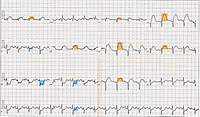
Photo from wikipedia
The blockage of blood in the vessels results in heart attacks and cardiac arrests which are referred to as myocardial infarction. Early detection of such infarction is feasible through percutaneous… Click to show full abstract
The blockage of blood in the vessels results in heart attacks and cardiac arrests which are referred to as myocardial infarction. Early detection of such infarction is feasible through percutaneous coronary intervention (PCI) based on electrocardiogram (ECG) monitoring. The variations in blood flow and clot are precisely observed through periodic ECG monitoring and previous correlations. This article introduces a concentrated value assessment model (CVAM) for determining PCI levels in treating myocardial infarction. The ECG observations from the previous observation sessions are accumulated and organized for validating the infarction rate. This requires the accompanying concentrated data like a heartbeat, blood pressure, and flow rate observed in different sessions. Based on the session observation and normal data correlation, the PCI level is recommended for the patient. In this analysis process, the value shift due to blocks and high and low blood pressure is accounted for through the deep learning paradigm. This paradigm correlates the above factors with the ECG values for precisely determining PCI from the last known concentration. The learning paradigm is trained based on session and normal observation data through different intervals. This model is validated using the metrics precision, analysis rate, diagnosis recommendation, and complexity.
Journal Title: BioMed Research International
Year Published: 2022
Link to full text (if available)
Share on Social Media: Sign Up to like & get
recommendations!